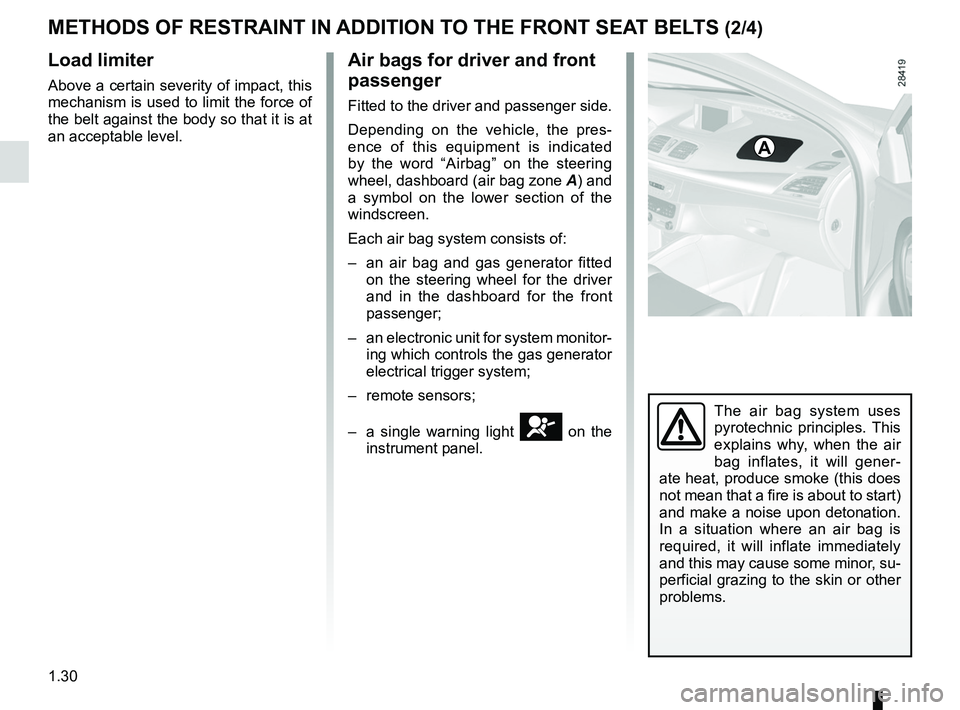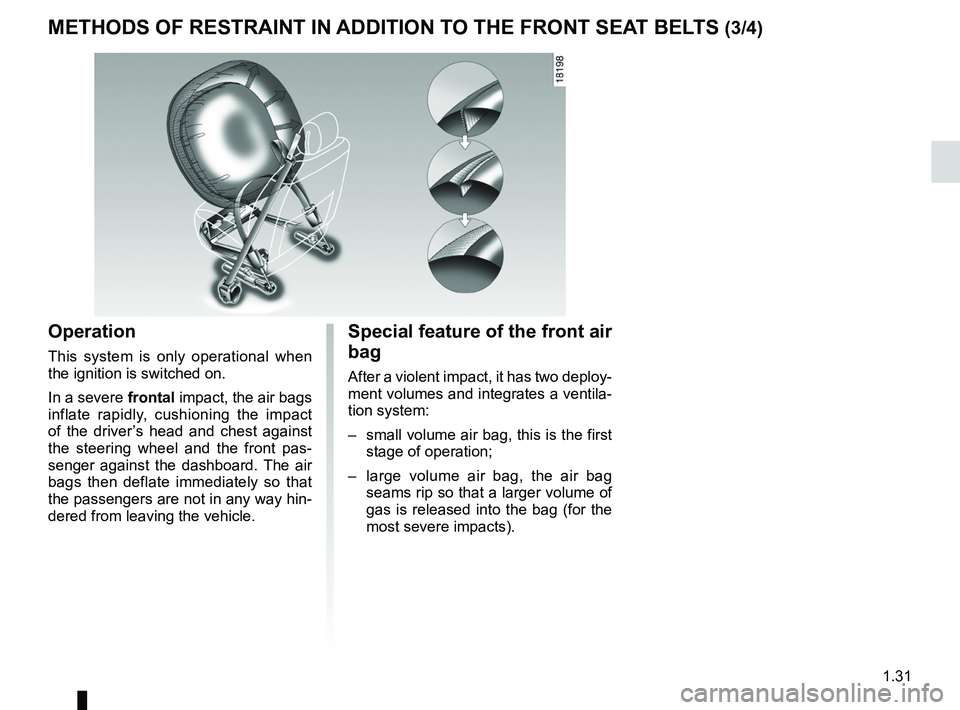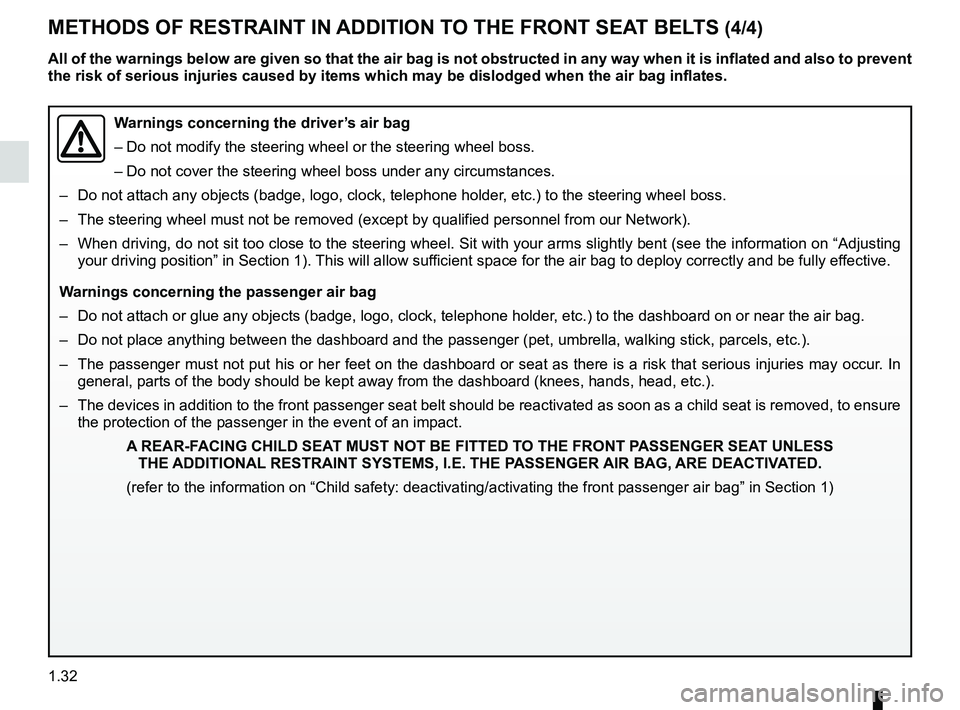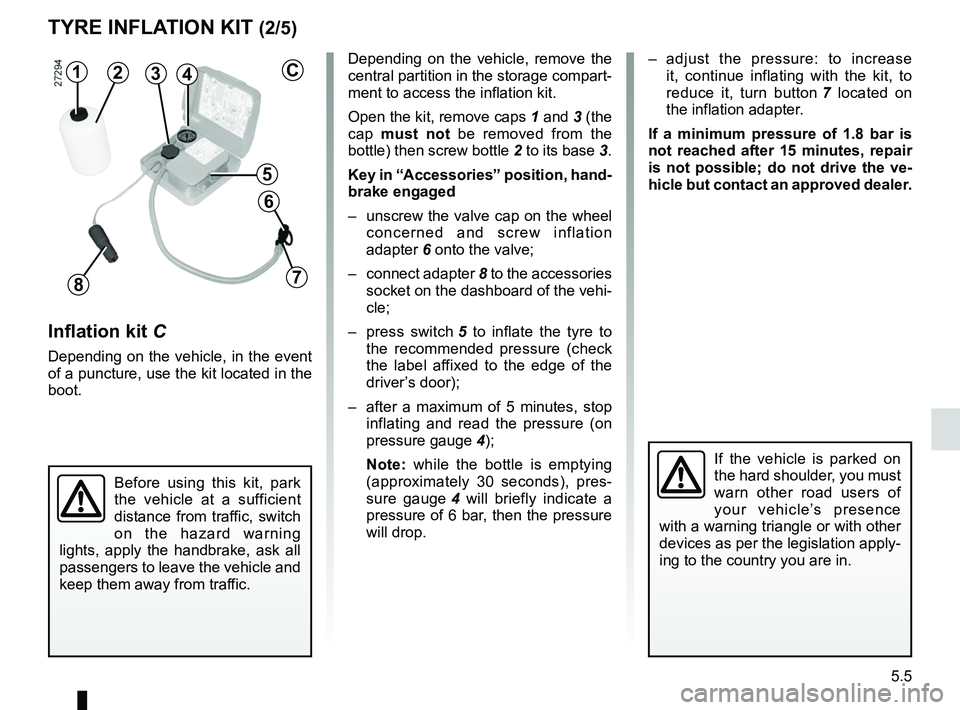dashboard RENAULT FLUENCE Z.E. 2012 Owners Manual
[x] Cancel search | Manufacturer: RENAULT, Model Year: 2012, Model line: FLUENCE Z.E., Model: RENAULT FLUENCE Z.E. 2012Pages: 195, PDF Size: 5.23 MB
Page 35 of 195

1.30
ENG_UD23032_2
Dispositifs complémentaires à la ceinture avant (L38 électriqu\
e - Renault)
ENG_NU_914-4_L38e_Renault_1
Jaune NoirNoir texte
methODS OF reStrAiNt iN ADDitiON t O the FrONt SeAt BeltS (2/4)
load limiter
Above a certain severity of impact, this
mechanism is used to limit the force of
the belt against the body so that it is at
an acceptable level.
Air bags for driver and front
passenger
Fitted to the driver and passenger side.
Depending on the vehicle, the pres -
ence of this equipment is indicated
by the word “Airbag” on the steering
wheel, dashboard (air bag zone A) and
a symbol on the lower section of the
windscreen.
Each air bag system consists of:
– an air bag and gas generator fitted
on the steering wheel for the driver
and in the dashboard for the front
passenger;
– an electronic unit for system monitor-
ing which controls the gas generator
electrical trigger system;
– remote sensors;
– a single warning light
å on the
instrument panel.
A
The air bag system uses
pyrotechnic principles. This
explains why, when the air
bag inflates, it will gener -
ate heat, produce smoke (this does
not mean that a fire is about to start)
and make a noise upon detonation.
In a situation where an air bag is
required, it will inflate immediately
and this may cause some minor, su-
perficial grazing to the skin or other
problems.
Page 36 of 195

JauneNoirNoir texte
1.31
ENG_UD23032_2
Dispositifs complémentaires à la ceinture avant (L38 électriqu\
e - Renault)
ENG_NU_914-4_L38e_Renault_1
methODS OF reStrAiNt iN ADDitiON t O the FrONt SeAt BeltS (3/4)
Operation
This system is only operational when
the ignition is switched on.
In a severe frontal impact, the air bags
inflate rapidly, cushioning the impact
of the driver’s head and chest against
the steering wheel and the front pas -
senger against the dashboard. The air
bags then deflate immediately so that
the passengers are not in any way hin-
dered from leaving the vehicle.
Special feature of the front air
bag
After a violent impact, it has two deploy -
ment volumes and integrates a ventila -
tion system:
– small volume air bag, this is the first
stage of operation;
– large volume air bag, the air bag
seams rip so that a larger volume of
gas is released into the bag (for the
most severe impacts).
Page 37 of 195

1.32
ENG_UD23032_2
Dispositifs complémentaires à la ceinture avant (L38 électriqu\
e - Renault)
ENG_NU_914-4_L38e_Renault_1
methODS OF reStrAiNt iN ADDitiON t O the FrONt SeAt BeltS (4/4)
Warnings concerning the driver’s air bag
– Do not modify the steering wheel or the steering wheel boss.
– Do not cover the steering wheel boss under any circumstances.
– Do not attach any objects (badge, logo, clock, telephone holder, etc.) to the steering wheel boss.
– The steering wheel must not be removed (except by qualified personnel from our Network).
– When driving, do not sit too close to the steering wheel. Sit with your arms slightly bent (see the information on “Adjusting
your driving position” in Section 1). This will allow sufficient space for the air bag to deploy correctly and be fully effective.
Warnings concerning the passenger air bag
– Do not attach or glue any objects (badge, logo, clock, telephone holder, etc.) to the dashboard on or near the air bag.
– Do not place anything between the dashboard and the passenger (pet, umbrella, walking stick, parcels, etc.).
– The passenger must not put his or her feet on the dashboard or seat as there is a risk that serious injuries may occur. In
general, parts of the body should be kept away from the dashboard (knee\
s, hands, head, etc.).
– The devices in addition to the front passenger seat belt should be reactivated as soon as a child seat is removed, to ensure
the protection of the passenger in the event of an impact.
A reAr-FAciNg chilD SeA t mUSt NOt Be FitteD tO the FrONt PASSeNger SeA t UNleSS
the ADDitiONAl reStrAiNt SYStemS, i.e. the PASSeNger Air BAg, Are DeActiv AteD.
(refer to the information on “Child safety: deactivating/activating \
the front passenger air bag” in Section 1)
All of the warnings below are given so that the air bag is not obstructed in any way when it is inflated and also to prevent
the risk of serious injuries caused by items which may be dislodged when\
the air bag inflates.
Page 52 of 195

JauneNoirNoir texte
1.47
ENG_UD28761_4
Sécurité enfants : désactivation/activation airbag passager ava\
nt (L38 - X38 - Renault)
ENG_NU_914-4_L38e_Renault_1
3
chilD SAFetY : deactivating, activating the front passenger airbag (2/3)
A
A
The markings on the dashboard and
labels A on each side of the passen -
ger sun visor 3 (for example, the labels
shown above) will remind you of these
instructions.
A
DANger
S i n c e f r o n t p a s s e n g e r
airbag triggering and the
position of a rear-facing
child seat are incompatible, Never
use a restraining device for rear -
facing children on a seat with an
A ctiv Ate D A irBA g in front of it.
This provides a risk of DeAth or
SeriOUS iNJUr Y to the chilD.
Page 55 of 195

controls ................................................. (up to the end of the DU)
dashboard ............................................. (up to the end of the DU)
driver’s position .................................... (up to the end of the DU)
1.50
ENG_UD23033_2
Poste de conduite à gauche (L38 électrique - Renault)
ENG_NU_914-4_L38e_Renault_1
Jaune NoirNoir texte
Driving position
DriviNg POSitiON: leFt-hAND Drive (1/2)
123456891011
121314
16
21
19
15
7
17
20
2522242326
18
Page 57 of 195

driver’s position .................................... (up to the end of the DU)
dashboard ............................................. (up to the end of the DU)
controls ................................................. (up to the end of the DU)
1.52
ENG_UD23034_2
Poste de conduite à droite (L38 électrique - Renault)
ENG_NU_914-4_L38e_Renault_1
Jaune NoirNoir texte
DriviNg POSitiON: right-hAND Drive (1/2)
2378
18
11
23
610
16171226
21
9
2514
54
15
1
22
20
13
24
19
Page 110 of 195

JauneNoirNoir texte
3.7
ENG_UD23016_2
Climatisation automatique (L38 électrique - Renault)
ENG_NU_914-4_L38e_Renault_3
AuT omATIc clImATE coNTRol (4/5)
Rear screen de-icing/
demisting
Press button 9 : the integrated indica -
tor light comes on. This function per -
mits rapid demisting/de-icing of the rear
screen and de-icing of the door mirrors
(on equipped vehicles).
To exit this function, press button 9
again. Demisting automatically stops
by default.
12
WThe air flow is directed to the
windscreen and the front side
window demisting vents.
×The air flow is distributed be -
tween all the air vents, the
front side window demisting vents, the
windscreen demisting vents and the
footwells.
¿The air flow is directed mainly
towards the footwells.
¾The air flow is directed towards
the dashboard vents and the
footwells.
½All the air flow is directed to the
dashboard vents.
In this situation, the distribution of air in
the passenger compartment, which is
no longer automatically controlled, ap -
pears on the display.9
Adjusting the distribution
of air in the passenger
compartment
There are five air distribution options.
Press switch 5 to scroll through them.
The arrows located in area B on the
display 13 combine to show you the
distribution selected:
5
B13
Page 127 of 195

bonnet................................................... (up to the end of the DU)
maintenance: mechanical ...................................... (up to the end of the DU)
4.2
ENG_UD20065_2
Capot moteur (L38 - X38 - Renault)
ENG_NU_914-4_L38e_Renault_4
Jaune NoirNoir texte
Bonnet
Opening the bonnet
Lift the bonnet, release stay 4 from its
holder 5 . For your safety, always fix it
in location 3 on the bonnet.
BOnnet (1/2)
1
2
The engine may be hot
when carrying out opera -
tions in close proximity. In
addition, the engine cooling
fan can come on at any moment.
Risk of injury.In the event of even a slight
impact involving the radia -
tor grille or bonnet, have the
bonnet lock checked by an
authorised dealer as soon as pos -
sible.
3
4
5
Do not do any work under
the bonnet when the vehicle
is charging or when the igni -
tion is switched on.
Unlocking the bonnet catch
To release it, lift tab 2.
To open, pull handle
1 , located on the
left-hand side of the dashboard.
Page 137 of 195

4.12
ENG_UD22866_8
Entretien des garnitures intérieures (X35 - X45 - X65 - J77 - X81 - \
J81 - X85 - X91 - B91 - K91 - D91 - X83 - X61 - X77 ph2 - X95 - B95 - D9\
5 - E95 - K95 - J95 - R95 -
ENG_NU_914-4_L38e_Renault_4
You are strongly recom -
mended not to use high -
pressure or spray cleaning
equipment inside the pas -
senger compartment: use of such
equipment could impair the correct
functioning of the electrical or elec-
tronic components in the vehicle, or
have other detrimental effects.
InteRIOR tRIM MaIntenanCe (2/2)
y ou should not:
You are strongly advised not to po -
sition objects such as deodorants,
scents, etc. near air vents, as this could
damage your dashboard trim.
Removal/replacing removable
equipment originally fitted in
the vehicle
If you need to remove equipment in
order to clean the passenger com -
partment (for example, mats), always
ensure that they are correctly refitted
and are the right way around (the driv-
er’s mat should be fitted on the driver’s
side, etc.) and fit them with the compo-
nents supplied with the equipment (for
example, the driver mat should always
be fixed using the pre-fitted mounting
components).
With the vehicle stationary, ensure that
nothing will impede driving (anything
obstructing the pedals, heel wedged by
the mat, etc.).
Page 142 of 195

JauneNoirNoir texte
5.5
ENG_UD28764_1
Kit de gonflage des pneumatiques (L38 électrique - Renault)
ENG_NU_914-4_L38e_Renault_5
TYrE INFLATION KIT (2/5)
143
5
6
78
2Depending on the vehicle, remove the
central partition in the storage compart-
ment to access the inflation kit.
Open the kit, remove caps 1 and 3 (the
cap must not be removed from the
bottle) then screw bottle 2 to its base 3.
Key in “Accessories” position, hand-
brake engaged
– unscrew the valve cap on the wheel
concerned and screw inflation
adapter 6 onto the valve;
– connect adapter 8 to the accessories
socket on the dashboard of the vehi-
cle;
– press switch 5 to inflate the tyre to
the recommended pressure (check
the label affixed to the edge of the
driver’s door);
– after a maximum of 5 minutes, stop
inflating and read the pressure (on
pressure gauge 4);
Note: while the bottle is emptying
(approximately 30 seconds), pres -
sure gauge 4 will briefly indicate a
pressure of 6 bar, then the pressure
will drop. –
adjust the pressure: to increase
it, continue inflating with the kit, to
reduce it, turn button 7 located on
the inflation adapter.
If a minimum pressure of 1.8 bar is
not reached after 15 minutes, repair
is not possible; do not drive the ve-
hicle but contact an approved dealer.
Inflation kit C
Depending on the vehicle, in the event
of a puncture, use the kit located in the
boot.
Before using this kit, park
the vehicle at a sufficient
distance from traffic, switch
on the hazard warning
lights, apply the handbrake, ask all
passengers to leave the vehicle and
keep them away from traffic.
If the vehicle is parked on
the hard shoulder, you must
warn other road users of
your vehicle’s presence
with a warning triangle or with other
devices as per the legislation apply-
ing to the country you are in.
C